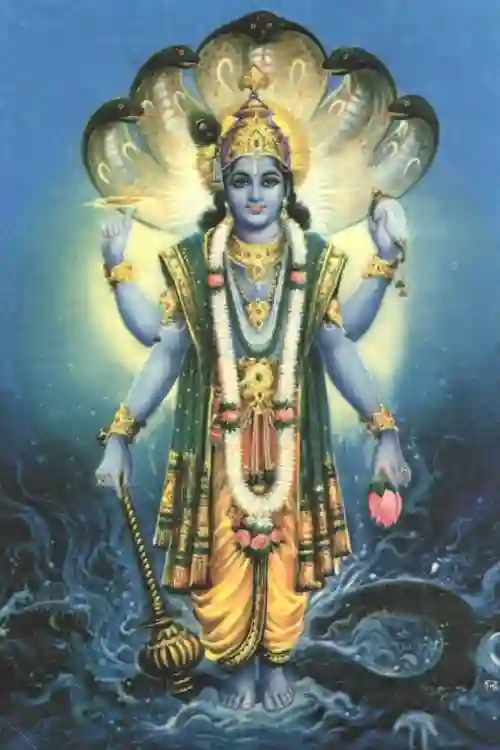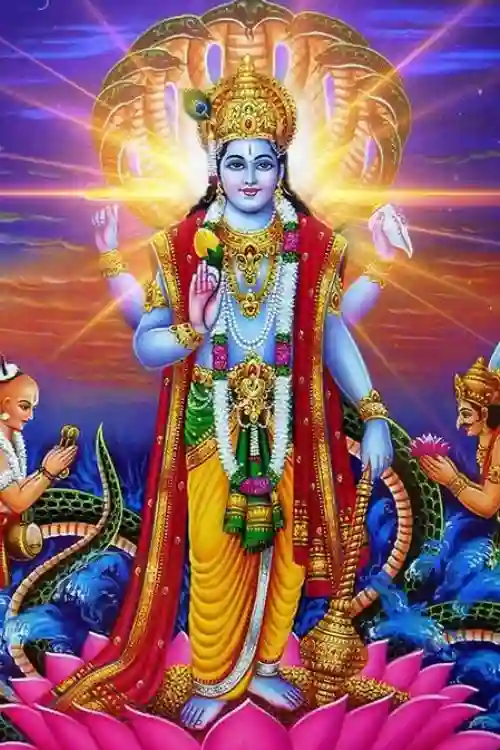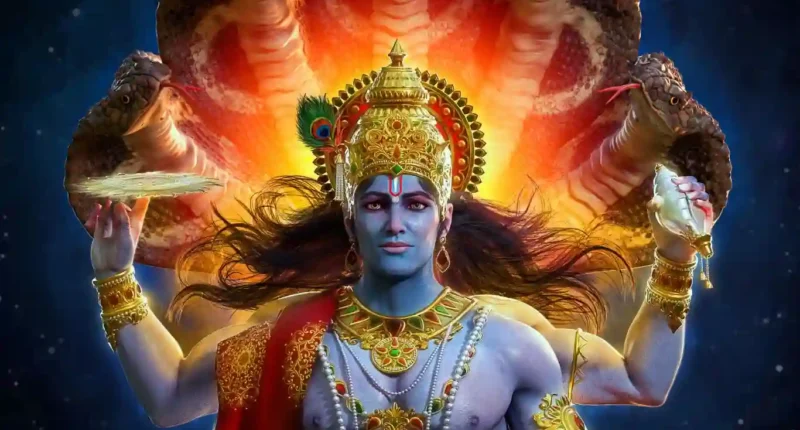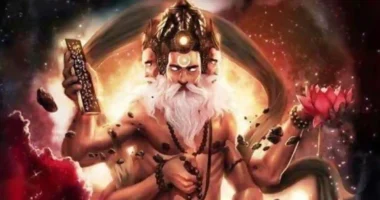Lord Vishnu is one of the most important deities mentioned in Hinduism. Vishnu is considered the supreme being and is a part of the Trimurti – the three supremely divine deities – along with Lord Brahma as well as Lord Shiva. Within the Trimurti, Lord Vishnu takes on the role of ‘the Preserver’ and also ‘The Protector’. As his title suggests, Lord Vishnu’s responsibility includes the protection and preservation of the universe in its best form.
Whenever Lord Vishnu is depicted in the stories of mythology, he either takes on a benevolent persona or rather a fear-inducing personality. The goddess Lakshmi, who is believed to be the Goddess of Prosperity, is Lord Vishnu’s consort and is almost always depicted beside him in art or sculptures. Both Lord Vishnu and Goddess Lakshmi reside in the mythical place of Kshira Sagar. Vishnu often times can be seen lounging on a large serpent ‘Adishesha’, who is in a way a representation of time itself.

Lord Vishnu considered his duty as the preserver and the protector of this world incredibly important. Ever since Lord Vishnu set his foot on Earth, there have been many instances where the safety of the people was threatened. Whenever destruction has reigned supreme, it is believed that Lord Vishnu has descended from the safety of his kingdom and come down to fight as many battles as he could. Lord Vishnu, however, never showed up as himself during these fights. Lord Vishnu believed it was his responsibility to restore the natural order of things whenever it was disrupted due to a variety of reasons. To do just this, Lord Vishnu would take on one of his avatars and descend onto the Earth to protect the universe and Dharma. There are on a primary level ten avatars ascribed to Lord Vishnu, known as the ‘Dashavatara’ which literally translates to ten avatars. Some of Lord Vishnu’s Avatars include Narsimha (a half man-half lion avatar), Rama (a Hindu deity and The Prince of Ayodhya), and Krishna (a Hindu deity, he played a major role in the Mahabharata).
Lord Vishnu, while popularly is known as such, there are almost thousands of names that have been used to refer to him in the ancient texts and scriptures. These names sometimes also include his Dashavataras, while other times not. In the epic ‘Mahabharata’ alone, Vishnu has been referred to by more than a thousand names, some of which are: Hari, Lakshmikanta, Hrishikesha, Govinda.
It is a known fact that each deity present in the ‘Trimurti’ signifies something specific to itself. While Brahma holds the title of the Creator, and Shiva, as his antithesis, is the Destroyer, Vishnu takes on a much more moderate role and acts in a way as a balance between the two and becomes the Preserver and Protector. In Hindu philosophy, it is accepted that the universe, at large is made up of certain fundamental forces, that also to some extent make up everything and everyone else present in the universe. Specifically, it is believed that there are three fundamental forces and each of the deities of this ‘Trimurti’ represents one of these forces. Brahma presides over Rajas, as it is the guna of creation, Shiva presides over Tamas, guna of destruction and finally, Vishnu presides over the guna of preservation, Sattva.

Something that makes Lord Vishnu unique is his ability to manifest himself as different avatars from time to time, whenever there has been a need for them. The term ‘Dashavatara’ is most popularly known due to the legend revolving around Lord Vishnu and his avatars. In the ancient epic, Mahabharata, Vishnu tells Narada of every avatar he will be appearing in which ranges from a Hansa (swan) right upto Lord Rama and Lord Krishna. The last avatar that Lord Vishnu would take is Kalki – the avatar that is prophesied to be the end of the Kal Yug (Age of Destruction). Another important piece of ancient Indian literature, The Puranas, has listed some of Lord Vishnu’s avatars, among which, the Manav Purana specifically mentions a total of 42 avatars of Vishnu. Mainly, however, the focus has always been on the ‘Dashavatara’, which includes the following:
Matsya (The Fish), Kurma (The Tortoise), Varaha (The Boar), Narasimha (Man-Lion), Parshurama (one of the Chiranjivs), Rama (Hindu deity and Ruler of Ayodhya), Krishna (Hindu deity), Buddha (ancient philosopher and founder of Buddhism), and lastly, Kalki (the one who will end the Kal Yug).
Lord Vishnu is a deity originating from the Rigveda, however, his prominence in the text was not much compared to some of the other deities. In all of the Rigveda, only a total of five hymns are dedicated to Lord Vishnu, himself, but he is mentioned in a few of the other hymns. According to Vedic Literature, Lord Vishnu belongs to the highest plane of existence where the Self, itself exists and is believed to be the one who supports the heaven and Earth.

The Upanishads, which are later texts in the Hindu philosophy which discuss topics such as ethics, consciousness, ontological knowledge and methods of worship, among others. In this piece of literature on Hindu philosophy, there is a specific Upanishad outlining the details surrounding Lord Vishnu, called the Vaishnav Upanishads. These texts view Lord Vishnu as the highest metaphysical reality, often known as Brahman.
As far as the Puranas – another ancient text of Hindu philosophy – are concerned, there are innumerable stories regarding Lord Vishnu. There are some that cite him as the Hiranyagarbha (the golden egg from which the universe and all the creatures within it were created). A specific piece of the Puranas, The Vishnu Purana solely features Vishnu as its central figure of the entire universe. A total of twenty-two chapters are used to describe Lord Vishnu and his greatness. Vishnu is also mentioned in a few other Puranas, namely the Bhagavata Purana, which conveys the sentiment that Vishnu in reality is equivalent to the Brahman. The belief that Vishnu is the Brahman forms the basis of the Vaishnav Philosophy.
Vishnu Temples have been a part of the Indian continent from the very ancient times. The earliest record of a Vishnu Temple in India is the Sarvotobhadra Temple in the historic city of Jhansi, Uttar Pradesh. Another prominent Vishnu Temple in India is the Padmanabhaswamy Temple in Thiruvananthapuram, Kerala. The icons and the statues of Lord Vishnu him to be dark blue-skinned. His body would be adorned with various jewels and he is usually depicted with four arms in artworks and statues. Often, Vishnu is depicted holding a shankha
(a conch), a chakra (a weapon discuss), a padma (a lotus flower).
Also Read: 3 Hindu gods also known as Trimurti | Brahma (creator) | Vishnu (preserver) | Mahesh (destroyer) | Explained



